Lecture Attendance: Who Comes, Why They Come, and What It All Means
Students at Yale feel no obligation to attend lecture. They often tell me that if they aren’t getting anything out of lecture, they’ll just stop going. As an economist, the idea that students are simply making a rational choice appeals to me. As a professor who currently sees about half his students coming to lecture, I find it somewhat distressing.
Sam Moulton, Director of Educational Research and Assessment at the Harvard Initiative for Learning and Teaching (HILT) believes lecture attendance is a measure of engagement with the class, and is very important to learning. I agree for two reasons. First, when lecture attendance is voluntary, students signal their engagement with the class by attending. Second, some lectures actively induce engagement with students. This can be explicit through the use of clickers and active problem solving, or implicit by teaching in a way that holds students’ attention and makes them think deeply about the material.
Complicating matters, lecture attendance is also affected by the resources the professor provides outside the classroom. Does the book say everything the professor says in lecture? Are professors providing access to online video of the lectures? Do they post detailed slides or notes? Any of these might encourage a student to spend their time reading or watching instead of going to class.
It’s not obvious how we should interpret data on lecture attendance, but I think attendance rates are at least partially a measure of course quality. We might also be able to see interesting patterns across the semester, and learn something by comparing classes that have high versus low attendance. This is what drove me to start counting students in my lecture early this semester. In hindsight, I wish I had started even earlier and been more systematic, but with two weeks left in the semester, this is what I have:
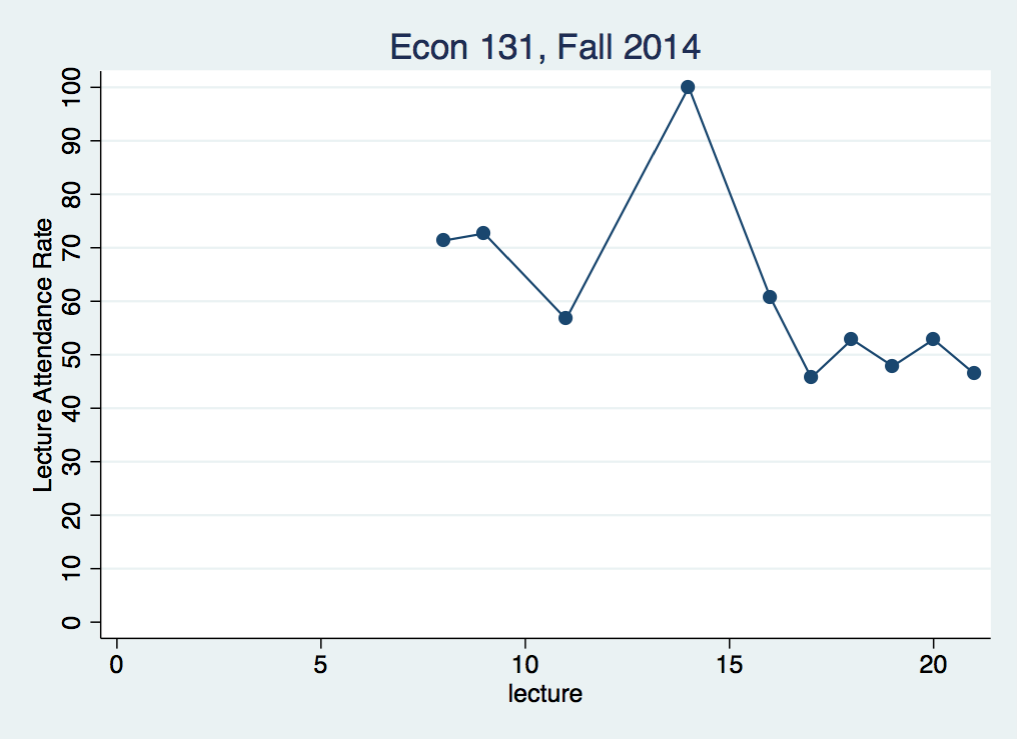
We see a steady decline with a big spike in the middle for the midterm exam.
You may have read in the news recently that Harvard got into some hot water when it installed cameras in several lecture halls that automatically photographed students during class. Faculty weren’t told about this ahead of time and students were never notified at all. Even though we live in a world of security cameras and you can argue that the lecture hall is a public space, many faculty and students were outraged. It all could have been avoided with better pre-study communication, but for the record, the Harvard email scandal was a much bigger ethical lapse than this.
What got lost in the secret photo story was that the purpose of the picture taking was solely to measure lecture attendance rates. The pictures were automatically processed and I don’t believe anyone every actually looked at them. In September, at the HILT Conference, Sam Moulton reported some very interesting results based on this data. You can watch the full 17 minute presentation on video, but here are his main findings:
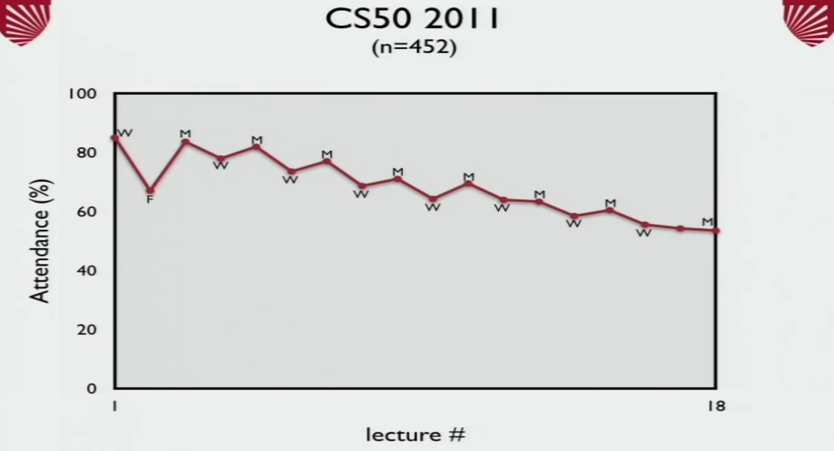
The first picture Sam shows is not actually from the camera data, but from survey data collected by Jeffrey Malan during his 2011 CS50 class. He sees high levels of attendance at the beginning of the semester and a gradual decline to about 50% by the end. CS50 is one of the most highly regarded college classes in the world, and it’s amazing to me that just half the students show up for lecture at the end of the semester.
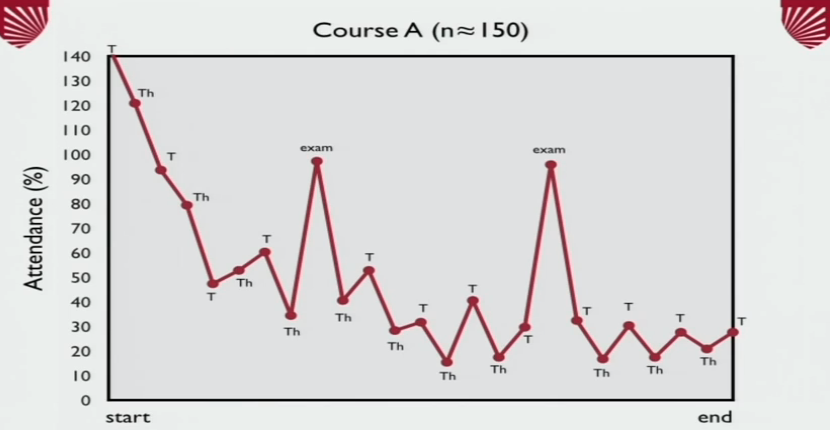
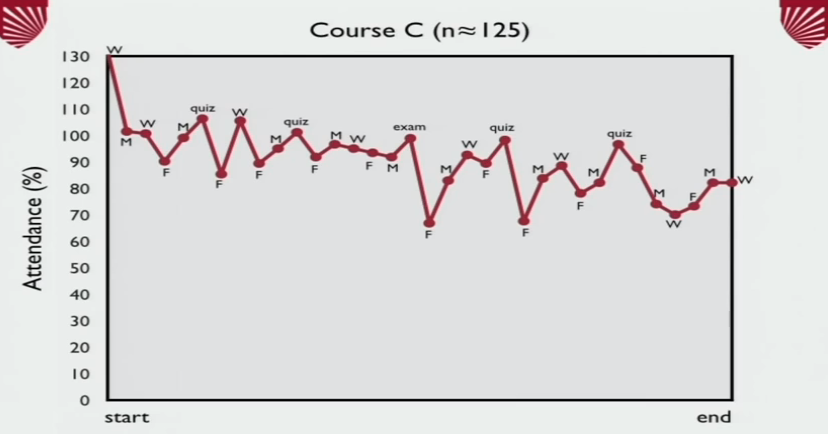
The automatic cameras gave Sam objective measures of daily attendance for 10 classes. Above you see two of these ten classes. The overall average attendance rate of the 2000 students was about 60%, but the more interesting story is the huge range: from 35% to 95%. Like Malan’s CS50, all classes saw a steady decline during the semester:
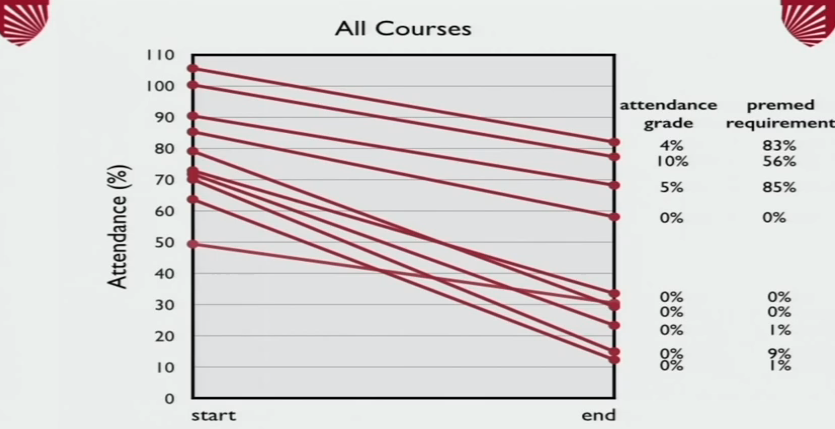
But what explains these big differences? With just 10 data points, this is difficult to establish, but Sam noticed two key differences between the top 3 classes and the rest: Grades depend on attendance in the most attended classes, and the students in those classes are disproportionately there because the classes satisfy a pre-med requirement. He doesn’t explicitly report average course ratings for the classes or whether video lectures were available, but he implies there is little association between these measures and attendance rates.
The other day I had lunch with Steve Berry who is currently teaching one of the largest classes at Yale: Econ 115, Intro Micro, currently has 370 students. I asked what his average attendance rate was and he said it was high but that he’d never counted. Later that day he reported that a TF counted 59 empty seats in a lecture hall that holds 370 giving him an impressive 84%. What’s different between his class and my class? I think in general, freshmen are more likely to attend lectures. My students have access to video lectures within 30 minutes of the end of class. And maybe he’s just a better lecturer. More research required.